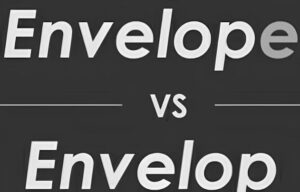Language can be a difficult environment to navigate especially when it comes to words that sound similar but have diverse meanings and spellings. Even the most seasoned writers are frequently perplexed by the phrases “envelope” and “envelop”. Though they have a similar sound, their usage in phrases is quite different. To assist you grasp these two terms, we will go over the meanings, distinctions, and correct usage of envelope
and envelop. By the end of this article you will have a solid knowledge of how to utilize envelope and envelop correctly ensuring that your writing is exact and polished.
The Meaning of Envelope
The term envelope refers to a flat which is generally a paper container that is used to hold a letter, document or small item. When you think of an envelope, imagine a rectangular paper package in which you insert a letter before mailing it. It is a crucial component of both personal and professional communication ensuring that written papers are safely transmitted from one location to another.
An envelope can also refer to something that wraps or surrounds another item. For instance, in environmental science, the word might refer to the outer layer of gasses around the earth, known as the atmospheric envelope. Also in daily use, it most usually refers to the paper container used for mailing.
Common Sentence Uses for Envelope
To understand the right usage of envelope, let us look at a few examples:
- Getting a Letter: She placed the invitation in an elegant envelope before sending it to her friend.
- Environmental Context: The Earths gaseous envelope shields us from harmful solar radiation.
- Figuratively: The project pushed the envelope of what was considered possible in technology.
Each of these instances uses envelope as a noun to describe anything that encloses or surrounds another object. Whether it is a real letter or a symbolic border, the phrase envelope refers to anything that wraps around or contains another object.
The Meaning and Usage of Envelop
Envelop is a verb that means to totally cover or surround anything. Unlike envelope, which is a real item, envelop is a verb. When you envelop something, you are enveloping or encircling it, usually in a protective or encompassing way. The term can be used in both literal and metaphorical settings.
For example, you may say, “The fog began to envelop the city,” implying that the fog is spreading across and enveloping the entire area. In a figurative sense, one may remark, “A feeling of sadness enveloped her,” meaning that the emotion encompassed or overpowered her.
Common Sentence Uses for Envelop
Consider the following examples to demonstrate the use of envelop:
- Literal Use: The dense fog will envelop the coastline by morning.
- Emotional Context: As the night darkened, he felt a sense of dread.
- Protective purpose: The security measures are designed to envelop the entire facility in safety.
In these cases, envelop is used as a verb to indicate the process of entirely encircling or enclosing something. The term envelop refers to entire covering or encasement, whether it be fog engulfing a city or an emotion overtaking a person.
Distinctive Features In between Envelope and Envelop
While envelope and envelop are similar in spelling and sound, they fulfill fundamentally distinct grammatical roles in a phrase. The most notable distinction is in their parts of speech: envelope is a noun, but envelop is a verb. This distinction is significant because it influences how each word is utilized in a phrase.
- Part of the speech
Envelope: Noun
Envelope: Verb in a Sentence:
- Function in a Sentence:
Envelope: Refers to an object that encloses or contains something.
Envelop: Defines the activity of enveloping or covering something.
- Usage Example:
Envelope: She sealed the letter inside the envelope.
Envelop: The warm blanket will envelop you as you sleep.
Note: This etymology background demonstrates how both terms are founded in the notion of wrapping or enclosing, but have developed to fulfill different roles in the English language.
Common Mistakes and How to Avoid Them
1. Identify the Part of Speech:
Given their close spelling and sound, it’s no wonder that envelope and envelop are frequently confused in writing. A typical error is using envelop when an envelope is needed, and vice versa. This section will help you prevent such mistakes by offering suggestions and tactics for distinguishing between the two.
2. Identify the parts of speech:
Before employing either term, consider if you need a noun or a verb. When referring to an item that includes something, envelope is the appropriate term. The term envelop is applicable for describing an action of covering or enveloping.
3. Practice Makes Perfect
Routinely work on forming phrases that utilize both envelope and envelop in different settings. The more you utilize these words accurately, the simpler it will be to recognize between them.
By keeping these rules, you can decrease the possibility of utilizing envelope and envelop reciprocally in your composition.
Examining the Origins of Envelope and Envelop
Understanding the origins of words may frequently shed light on their meanings and usage. The terms envelope and envelop are both derived from the French word enveloper, which means “to wrap up”. This same origin explains their similar connotations, since both terms contain the idea of wrapping or encircling something.
Envelope: The term envelope first emerged in English in the early 18th century, originally referring to a wrapping or covering. Over time, its connotation evolved to explicitly refer to the paper covering used for letters.
Envelop: The verb envelop has been in use since the late 14th century, with the meaning “to wrap or surround”.
This etymology background demonstrates how both terms are founded in the notion of wrapping or enclosing, but have developed to fulfill different roles in the English language.
The Importance of Correct Usage in Professional Writing
Precision is essential for professional and academic writing. Misusing envelope and envelop might cause misunderstanding or misinterpretation, jeopardizing the clarity of your message. For example, if a business document uses envelop instead of envelope, the reader may be temporarily puzzled, detracting from the communication professionalism.
Ensuring the usage of envelope and envelop not only improves the clarity of your work, but also exhibits your attention to detail and grasp of English. This is especially crucial in disciplines that need accurate communication, such as legal writing, technical documentation, and academic research.
Conclusion
Knowing how to envelope and evelop is basic for clear and fruitful correspondence. While these two terms show up and sound comparative, their implications and jobs in an expression are very unique. The term envelope alludes to a holder or covering, most normally a paper bundle envelope for mailing. Interestingly, envelop is an action word that alludes to the most common way of encompassing or encasing something.
Figuring out the qualifications between these terms and rehearsing their appropriate use will permit you to keep away from continuous mix-ups and ensure that your composing is both precise and clean. Whether you are composing a business letter, an email, or a scholastic paper, understanding when to utilize envelopes and when to utilize encompass can assist you with conveying all the more really.
Recall that in the space of words, the subtleties are significant. By really focusing on the appropriate use of words like envelope and envelop , you might work on the nature of your composition and leave an effect on your per users. With experience and cautious review, you will find that choosing envelope and evelop turns out to be natural permitting you to articulate your thoughts obviously and certainly.

